Interdealer brokers and market operator BGC Group intends to launch its futures exchange for US Treasury and SOFR contracts this summer to compete with CME Group’s US interest rate complex.
Chair and CEO of BGC Group, Howard Lutnick, outlined the challenges and opportunities that the firm saw in the upcoming launch of FMX after CME Group reported a good year in 2023, with average daily volume (ADV) of 24.4 million contracts.
BGC announced in January that its FMX Futures Exchange had received regulatory approval from the US Commodity Futures Trading Commission (CFTC). Lutnick said at the time that the firm will combine its Fenics UST cash platform with the new exchange, mirroring the CME Group’s ownership of Brokertec’s Treasury trading operation and CME Treasury futures trading business.
On the firm’s Q4 2023 earnings call, Lutnick said: “Since our launch, Fenics UST has grown rapidly, reaching 25% market share during the third quarter of 2023, up from 18% only a year ago. We will execute the same playbook with our FMX Futures Exchange.”
In its first year FMX will look to connect with trading firms. “The first year will be one of robust connectivity,” Lutnick said, with BGC possessing a substantial advantage because the firm is already connected to virtually all of the relevant trading firms thanks to its rates business.
“I don’t know that there’s ever been a firm with a better advantage in that regard,” Lutnick said. The firm does not see many barriers to launch, Lutnick added, with the second year set to be focused on transactions and the third year, “fundamental competition” with CME Group.
Lutnick pointed to FMX’s US Treasury business, which has grown its market share by one or two points every quarter for a year, as evidence the firm has a chance against the incumbent CME.
“These are points being taken off the Chicago Mercantile Exchange,” Lutnick said. “The big heavyweight champ can be hit. You’re watching FMX hit, and we are coming with futures launching this summer.”
A key competitive advantage will be based on the netting off of clearing margins, he said, which was helped by partnering with LCH.
“What the CME does is called two-pot and what we will be doing with the LCH is called one-pot clearing,” he explained. “With two-pot clearing, the CME holds lots of margin and the DTCC holds a lot of margin. And they have a nice working relationship with each other, they trust each other and they give each other a discount because the offsetting position is [held by] your friends you can go only so far.”
Holding both pots within a single entity allowed greater discounting, he said, creating greater savings for users.
“You net them and say, if you only have basis risk that’s 3% it’s not 75% off [as a discount], it’s 97% off, but you can’t go past 75% off when you don’t hold both pieces of the puzzle,” he said. “Mathematically we will be superior, 97% is better than 75%, just put us toe-to-toe in the ring and we’re on.”
©Markets Media Europe 2025


























